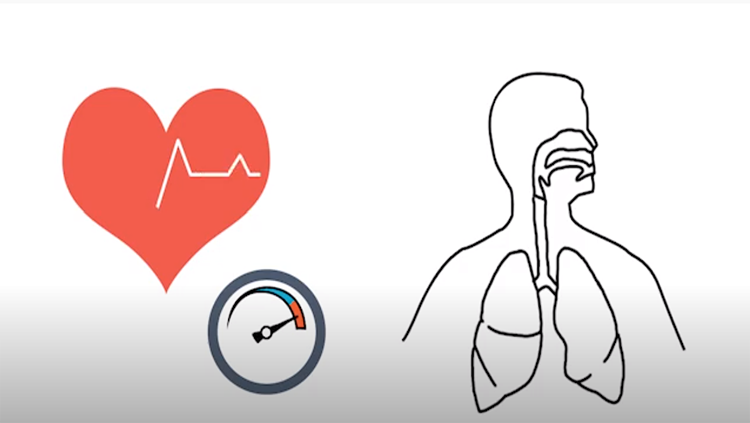A newborn infant can take steps. Why can't she walk?
- Published3 Jul 2013
- Author John Kubie
- Source BrainFacts/SfN
Newborn infants can do lots of things. They can breathe, swallow, see, hear, startle, grasp, withdraw from noxious stimuli, taste, smell, cry and more. An experienced physician can elicit a broad range of behaviors. Perhaps surprisingly, the basic spinal circuitry for walking is present. If you take a neonate, support its weight, and put the feet on the ground, the infant will begin "stepping"; that is, take alternating steps, left-right-left, on the ground. How is this done? Does this suggest that an infant, with the right training, could walk?
Where does 'Stepping' come from?
How do the infant's brain, spinal cord and limbs execute the behavior called stepping? Is the infant's cerebral cortex commanding the spinal cord, "move left foot" followed by "move right foot"? The consensus is, no, the brain is not involved. The stepping motions are organized in the spinal cord. Evidence for this idea comes from a wide variety of animals who, after the spinal cord is separated from the brain, still show basic locomotor patterns. These animals cannot balance, but they show alternate stepping with left and right legs when body is supported and feet touch the ground. The conclusion is that the basic circuitry for locomotion is organized in the spinal cord.
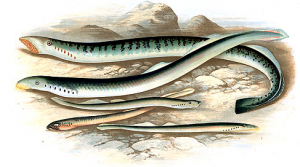
The intrinsic circuitry in the spinal cord has been investigated in a primitive fish, the lamprey (Goulding, 2009). In intact lampreys, locomotor patterns flow from head to tail, while right and left sides of the body alternate in contractions, producing a "slithering" swimming pattern. When the lamprey spinal cord is removed from the body and disconnected from the brain, identical activity patterns are seen. The circuitry in the isolated lamprey spinal cord is complex and is sufficient for its locomotion.
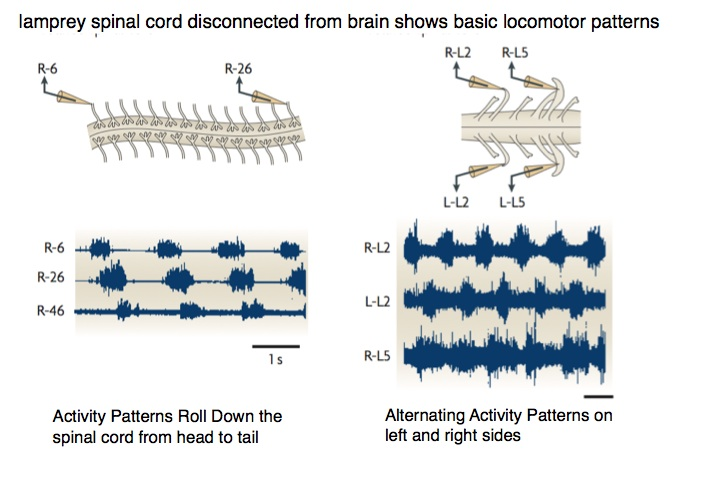
The intrinsic walking circuitry in the spinal cord an example of a "central pattern generator" or CPG. It's important to note that the walking CPG is not a reflex. Built into the spinal cord are sets of reflexes, such as the stretch reflex and the withdrawal reflex and CPGs. Reflexes are simple, phasic responses to stimuli. CPGs are stereotyped motor sequences, frequently rhythmic, that can be triggered by a variety of mechanisms. CPGs are not unique to the spinal cord; for example, CPGs organized in the brainstem include breathing and swallowing. Returning our attention to the infant, we now recognize that a primitive locomotor pattern, the locomotor CPG, is present in the infant's spinal cord and is responsible for the infant's stepping response. The general idea is that adult locomotion is erected upon the platform of spinal cord CPGs. During locomotion in the adult the motor cortex does not need to send descending signals for each muscle contraction; the CPG in the spinal cord can handle lots of the work.
Is it possible for a newborn baby to walk?

Why can't the infant walk? If we were to take a newborn and give it intensive walking training, could it walk very early in life, perhaps at one month? The answer here is no (or, to be more cautious, "very highly unlikely"). Walking takes more than turning on the spinal cord CPG. Perhaps the most important addition is balance, something the infant does not have. Humans only have two legs, making balance a complex task. The problem the brain has to solve is move the body so that body's center of gravity is directly above the feet. Balance relies on three sense modalities: the vestibular apparatus in the ear; vision and pressure sensation (from the feet). Let's examine these one at a time. The vestibular apparatus in the ear contains the balance organs: the semi-circular canals, the utricle and the saccule. These are sensitive to gravity forces, the position of the head in space and movements of the head. The vestibular nerve (part of the VIIIthcranial nerve) projects into the brainstem terminating in the vestibular nuclei. Neurons in the vestibular nuclei project to the spinal cord (vestibulo-spinal pathways) and are critical for balance. The vestibulo-spinal pathways are not mature at birth. The infant's spinal cord does not get a strong set of vestibular balance signals.
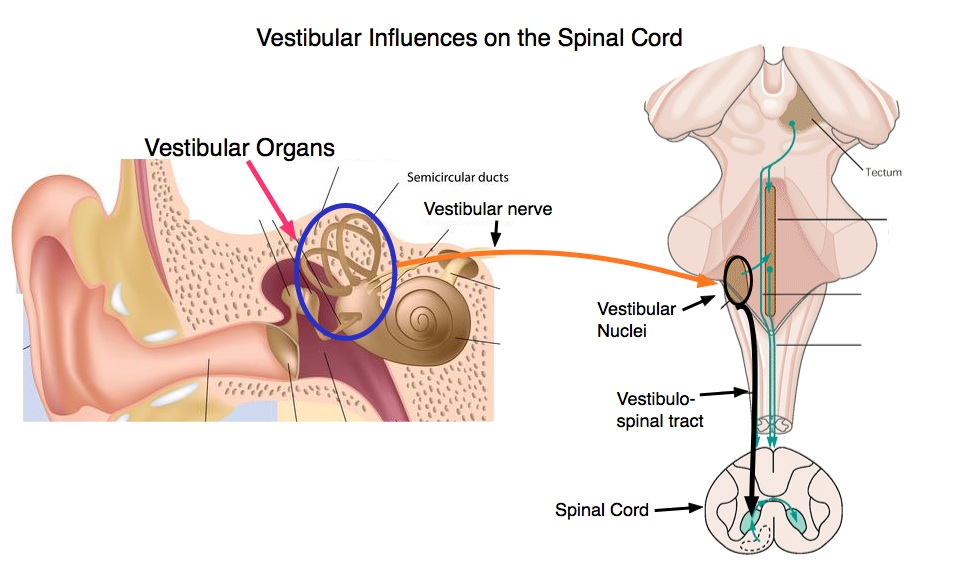
Vision also plays an important role in balance. You can demonstrate this to yourself by seeing how long you can balance on one foot with eyes open and try the same thing with eyes closed. The stability (or instability) of visual cues is an important signal that you are stable or falling. Vision is processed in the forebrain; the pathways from the infant's forebrain to spinal cord are not mature and functional.
Finally, pressure sensors from the feet are important. Although this sensory information enters the spinal cord, it is transmitted to the brain for processing. As noted above, the motor tracts that connect the infant's brain with spinal cord are largely non-funcational.
I've asserted several times that the pathways from the infant's brain to spinal cord are incomplete at birth. There is strong evidence for this. The figure below shows a pair of histological sections stained for myelin. The staining is such that brain tracts (myelinated axons) are black and gray matter is gray. The section on the left is from a newborn; the one on the right is from a 40 week old infant. The dramatic difference between these two is the white "hole" within the region of white matter in the infant spinal cord that isn't present at 40 weeks. This is exactly the region of the cortico-spinal tract, the motor pathway from cerebral cortex to spinal cord. In the newborn infant the cortico-spinal fibers are not myelinated. Myelin is the axon coating that permits rapid and efficient conduction of information (action potentials). At birth the myelin coats have not begun to form, so the cortico-spinal tracts can't function.
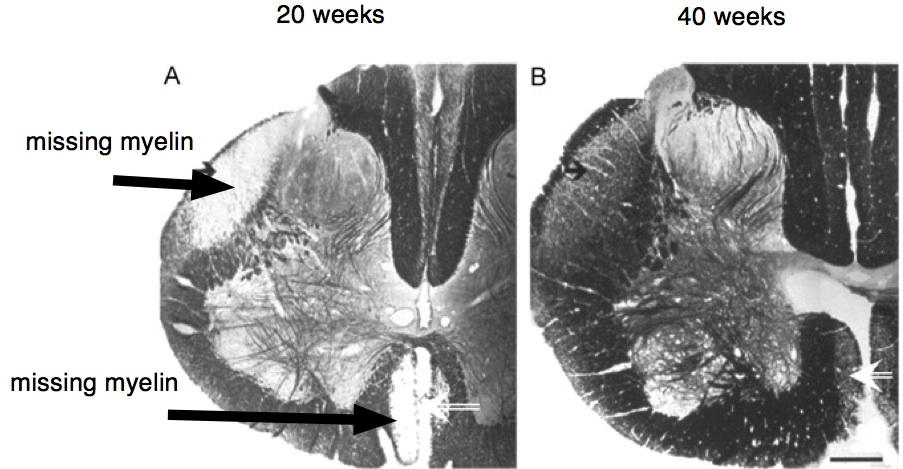
Adult-like locomotor patterns come much earlier for many species. For example, a newborn horse walks within hours of birth. There are two factors to consider. One is that humans are an "altritial" species, meaning that we are relatively poorly developed at the time of birth. As described in detail above, a newborn's spinal cord and brain are not ready for walking. Second, the human two-legged pattern of locomotion is particularly complex — balancing would be much easier if we had four feet on the ground. Walking feels simple, natural, and thought-free. It's not. Programming this remarkable capacity into our nervous system takes a particular level of development followed by years of trial-and-error learning.
Summary
In brief, an infant's stepping behavior is due to a Central Pattern Generator working at the spinal level. The brain makes use of Central Pattern Generators in developing complex adult behavior patterns. However, in the infant stepping behavior is a Central Pattern Generator without higher brain control. The baby will have to wait for fiber tracts to mature before taking her first functional steps.
The Society for Neuroscience and its partners are not responsible for the opinions and information posted on this page. Terms & conditions.
CONTENT PROVIDED BY
BrainFacts/SfN
References
1. Goulding, M. (2009). Circuits controlling vertebrate locomotion: moving in a new direction. Nature Reviews Neuroscience, 10(7), 507–518.
3. Ivanenko, Y. P., Dominici, N., Cappellini, G., Di Paolo, A., Giannini, C., Poppele, R. E., & Lacquaniti, F. (2013). Changes in the spinal segmental motor output for stepping during development from infant to adult. Journal of Neuroscience, 33(7), 3025–36a.
Adult-like locomotor patterns come much earlier for many species. For example, a newborn horse walks within hours of birth. There are two factors to consider. One is that humans are an "altritial" species, meaning that we are relatively poorly developed at the time of birth. As described in detail above, a newborn's spinal cord and brain are not ready for walking. Second, the human two-legged pattern of locomotion is particularly complex — balancing would be much easier if we had four feet on the ground. Walking feels simple, natural, and thought-free. It's not. Programming this remarkable capacity into our nervous system takes a particular level of development followed by years of trial-and-error learning.
Summary
In brief, an infant's stepping behavior is due to a Central Pattern Generator working at the spinal level. The brain makes use of Central Pattern Generators in developing complex adult behavior patterns. However, in the infant stepping behavior is a Central Pattern Generator without higher brain control. The baby will have to wait for fiber tracts to mature before taking her first functional steps.
CONTENT PROVIDED BY
BrainFacts/SfN
References
1. Goulding, M. (2009). Circuits controlling vertebrate locomotion: moving in a new direction. Nature Reviews Neuroscience, 10(7), 507–518.
3. Ivanenko, Y. P., Dominici, N., Cappellini, G., Di Paolo, A., Giannini, C., Poppele, R. E., & Lacquaniti, F. (2013). Changes in the spinal segmental motor output for stepping during development from infant to adult. Journal of Neuroscience, 33(7), 3025–36a.




